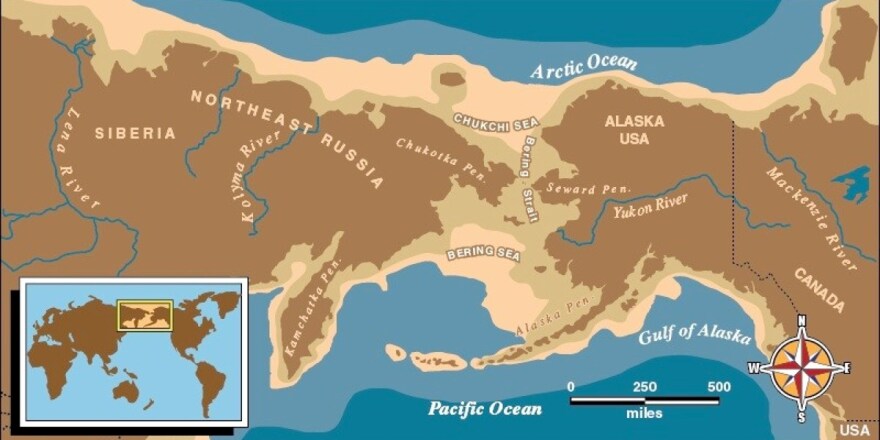This commentary was updated Oct. 8 2021
The U.S. is still calling next Monday's federal holiday "Columbus Day." But it's way beyond time to officially and definitively dump Columbus Day and replace it with a new, more American holiday.
Some now call it Indigenous Peoples Day (update: a day after this was published, President Biden officially designated it as such), to recognize the Native Americans — the first Americans — Columbus encountered.
I agree with that. But I might also propose calling it Beringia Day, for the now submerged land bridge that once connected the Old and New Worlds (more on that below).
WLRN is committed to providing the trusted news and local reporting you rely on. Please keep WLRN strong with your support today. Donate now. Thank you.
Either way, few holidays provoke as much partisan fury as Columbus Day, whose actual observance is October 12. That’s the day Christopher Columbus and his Spanish fleet sailed into the Bahamas in 1492 and “discovered America" — even though he never set foot in what would become the United States.
Liberals will come out in force to deface or pull down Columbus’ statues and declare him a colonialist monster. Conservatives will be out to revere him for bringing Christian European civilization to a heathen hemisphere.
We know today the “discovered America” part is bull. Cristoforo Colombo — his real, Italian name — “discovered” squat. He was just the latest Old World expeditioner to find the New World.
He joined a slew of predecessors, like the Viking Leif Erikson and, most important, the Native Americans who greeted Columbus.
Those were the same folks who, in Mesoamerica, had come up with an ingenuously accurate calendar and mathematical ideas like zero — and who, in Massachusetts, would later save the Pilgrims from starvation.
READ MORE: Miami's Anti-Racism Protests Get Caught Up in Our Columbus and Che Hypocrisies
And there lies the main reason for canning Columbus as the figure we venerate on the day we venerate the Americas. Calling him the “discoverer” of the world the Maya forged is as clueless as calling Elvis the “king” of the music Sister Rosetta Tharpe pioneered.
Things get more insulting when you consider Columbus’ record in the Americas. As soon as he jumped ashore he was sending many of his indigenous hosts to be enslaved back in Spain; and historical documents reveal he was often, yeah, the colonialist monster the protesters who spray-paint his statues claim.
Calling Christopher Columbus the “discoverer” of the world the Maya forged is as clueless as calling Elvis the “king” of the music Sister Rosetta Tharpe pioneered.
That doesn’t mean Italians and Spaniards shouldn’t take pride in his daring maritime feat or that it wasn’t a tectonically important moment in history. It certainly was.
But here’s an equally tectonic moment: the day, some 15,000 years ago, when Stone Age Asians summoned similar daring and hope — with no financial backing from Madrid — and crossed Beringia, from Siberia to Alaska, discovering America for real.
EARTH 2.0
Which brings me to my larger point: Columbus Day should be re-designated Beringia Day to celebrate not just humanity’s arrival in the New World but what being the New World means.
Columbus wasn’t seeking a hemisphere he didn’t know; he just thought he was blazing a quicker trail to the other side of the one he did know.
The first Beringia-crossers, on the other hand, knew they were headed to Earth 2.0 — and they went anyway, because they sensed in their own primitive way that what lay ahead was a new version of themselves as well as a new version of their planet.

That’s the mindset we inheritors of the New World are supposed to carry on.
Few have described it as trenchantly as Cuban independence hero José Martí in his seminal 1891 essay “Nuestra América.” It implores the denizens of this hemisphere to ditch “imitate” and embrace “create” as their “password.”
To create democratic governance, the joyfully syncopated rhythms of jazz and salsa, or freedom-boosting tools like the computer and internet — whose binary code foundations, lest we forget, owe a debt to the Maya, the Greeks of the New World, and that concept of zero.
In fact, says Martí: “Our Greece must take priority over the Greece which is not ours.”
Columbus is just an unseemly logo for the new Greece Martí envisioned.
That's especially true in 2021 — the year marking the 500th anniversary of the brutal Spanish conquest of the admittedly brutal Aztec empire in Mexico.
In the half millennium since that bloody result of 1492, Mexicans have actually gotten the October holiday right: they call it “Día de la Raza,” to commemorate not the trauma but the mixed and magnificent Euro-indigenous race, mestizaje, that emerged from that trauma.
Likewise, the U.S. holiday should shed its connection to the devastation that so often followed Columbus’ crossing — and focus more on the creation that so often echoes Beringia’s crossing.






